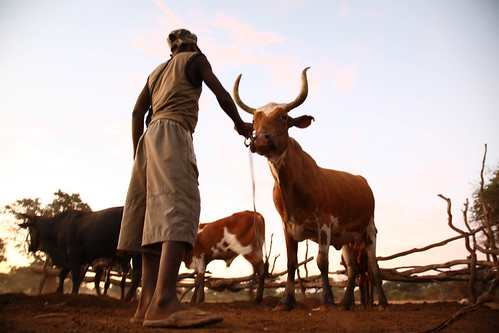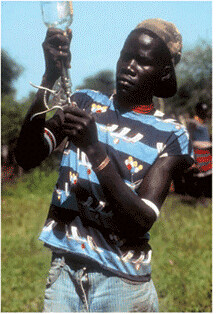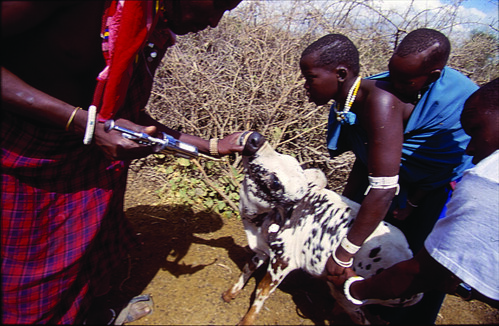Small-scale livestock-dependent agriculture in developing countries makes up one of three trajectories of global disease risk; here, cattle belonging to a widowed farmer in Garue, Mozambique, are brought in for the night by a herdsboy (photo credit: ILRI/Mann).
‘Current drivers and future directions of global livestock disease dynamics’ is a special feature published in the (online) 16 May 2011 issue of the Proceedings of the National Academy of Sciences (PNAS) of the USA. The authors of the paper are Brian Perry, Delia Grace and Keith Sones.
Irish veterinary epidemiologist Delia Grace leads a team researching animal health and food safety for trade at the International Livestock Research Institute (ILRI), based in Nairobi, Kenya.
In the PNAS paper, the authors write: ‘The current era of globalization is seeing unprecedented movements of people, products, capital and information. Although this has obvious implications for economies and ecosystems, globalization also affects the health of people and animals. This paper reviews changing patterns of livestock disease over the last two decades, discusses the drivers of these patterns, and plots future trajectories of livestock disease risk in an effort to capitalize on our understanding of the recent past and provide a guide to the uncertain future.’
While acknowledging the complexity of disease dynamics, the authors point to three main drivers of changing livestock disease dynamics: ecosystem change, ecosystem incursion, and movement of people and animals. Underlying these dynamics are the growing demand for livestock products (the Livestock Revolution) and increasing human population size.
The authors identify three trajectories of global disease dynamics:
‘(i) the worried well in developed countries (demanding less risk while broadening the circle of moral concern)
‘(ii) the intensifying and market-orientated systems of many developing countries, where highly complex disease patterns create hot spots for disease shifts
‘(iii) the neglected cold spots in poor countries, where rapid change in disease dynamics is less likely but smallholders and pastoralists continue to struggle with largely preventable and curable livestock diseases.’
On the topics of major trends in disease dynamics, the authors point out that ‘From a centuries-long and whole-world perspective, human wealth and health continue to improve, and animal health parallels this, showing an overall dramatic decline of infectious disease and shift to noncommunicable diseases. (This has been called the second epidemiological transition; the first epidemiological transition was 10,000 y ago, when human settlement led to a surge in zoonoses and crowd-related diseases.)’
However, the authors also say that ‘Although control and management of many endemic diseases in rich countries have improved, new diseases such as BSE and HPAI have emerged. Some consider that we face a third epidemiological transition of disastrous consequence in which globalization and ecological disruption drive disease emergence and reemergence; as occurred in the first epidemiological transition (associated with neolithic sedentarization and the domestication of livestock), the worst of the emerging diseases are likely to be zoonotic.’
The authors go on to consider ‘the drivers with greatest influence on livestock disease dynamics, namely increasing human population size and prosperity and the related demand-driven Livestock Revolution. . . . [W]e identify three overarching sets of animal diseases dynamics and associated control. Each system is facing different risks to livestock health, each has different determinants of disease status and capacity to respond, and each requires different approaches to resolve them.’
‘In the background,’ they say, ‘is the significant component of the world’s livestock enterprises in the hands of the very poor, for whom intensification is just not a realistic option and who are likely to be most vulnerable to disease resurgence. . . .
‘Although we call these [very poor livestock] systems cold spots for disease dynamics and emergence, they are inevitably hot spots for endemic diseases, periodic epidemics (such as Newcastle disease, which regularly wipes out village flocks), and neglected zoonoses, which significantly impact on human health. Because of the low densities of livestock, their remoteness, and the slow change in husbandry practices, these are probably not hot spots for emerging diseases. . . .
‘This review is prognostic rather than therapeutic, presenting implications for livestock disease in the 21st century. In an increasingly globalized world, deepening of the existing balkanization of livestock health status will create inevitable instability. The main challenges are (i) to speed the convergence of livestock health between the intensifying and intensified regions through improved coordination, communication, and harmonization and (ii ) to improve resilience of smallholder livestock systems, including the support of viable exits from livestock keeping.’
Read the whole paper in the Proceedings of the National Academy of Sciences: Current drivers and future directions of global livestock disease dynamics, by Brian Perry, Delia Grace and Keith Sones, 16 May 2011.
Read an ILRI brief: Why animals matter to health and nutrition, February 2011.
Read another ILRI News Blog article related to this topic: Adapting agriculture to improve human health—New ILRI policy brief, 21 February 2011.
Read an ILRI news release: Livestock boom risks aggravating animal ‘plagues,’ poses growing threat to food security and health of the world’s poor, 2 February 2011.







